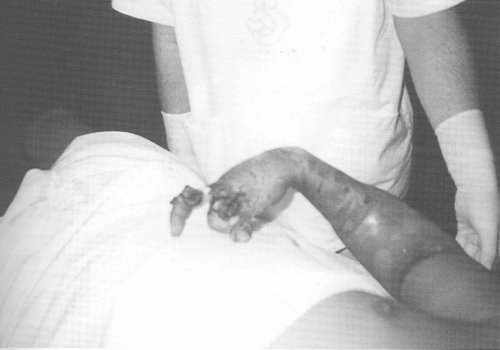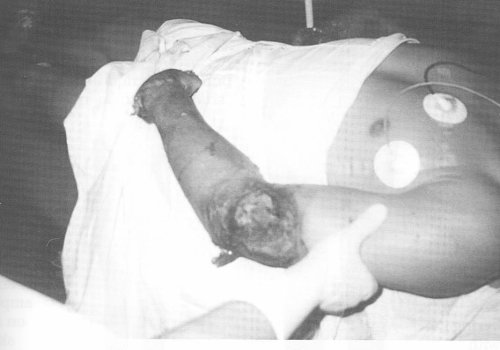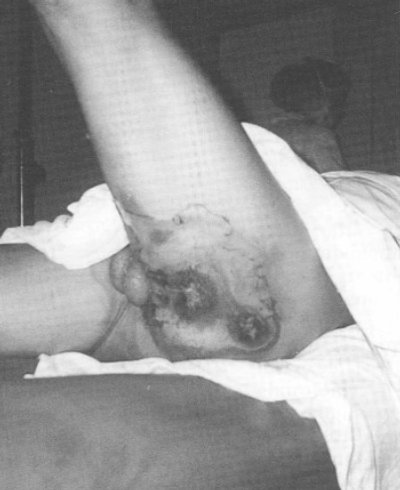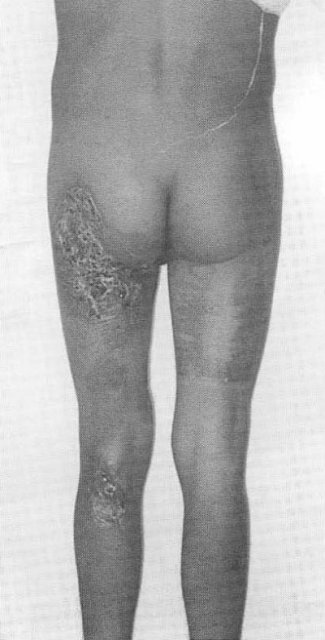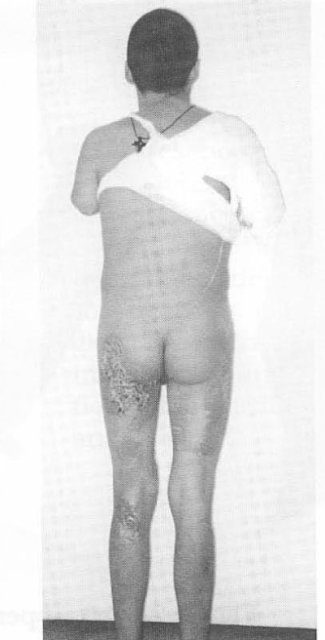CLINICAL ANALYSIS, TREATMENT AND PARTICULARITIES IN ELECTROCUTIONS The article presents the author's experience in the electrocution lesions treatment, the prevention of the inherently complications of this lesions, with the object of saving patient's life and social' reinsertion. The accumulated experience in the plastic surgery department of the clinical emergency hospital supports affirmation: electrocution is a plurforganical aggression which treatment involves a very good reanimation and an aggressive, radical, precocious and correct surgical treatment. The specific pathology of the clinical emergency hospital involves in most cases also the grave lesions by electrocution. The electrocution is a part in politrauma with multiple visceral lesion involving a multidisciplinary treatment and approach by a standardized therapeutic protocol. By a sustained effort we can estabilish now a correct diagnosis and treatment protocol, which's applying let us hope in saving this patients . Electrocution might be defined as a plurlvisceral lesional syndrome defined by the entrance and exit marks and the visceral lesions made by the passing of the electricity. As a specific characteristic of the electrocution is that the skin lesions are in most of limited cases limited in comparison with the tissue's profound destructions of extreme gravity, hidden by well status of the patient. The correct identification of the lesions is critical and needs the presence of a specialist who can tell the precise treatment of the lesions. In the absence of the adequate treatment the metabolic disorders leads without way back to exitus, any other tardive measure are inefficient in the patient reanimation. Electrocution lesions are the result of the conversion of the electric energy to thermic energy and the physic- chemical effects of the electric energy on the tissues. By Joule's law the quantity electric energy is directly proportional with the intensity, the resistance of the conductor and the contact time. Each tissue takes a quantity of energy suitable of it's electric resistance, the level of the lesions depending on that. The studies showed that the vascular and nervous lesions became evident from more than 45 C degrees. The electro-chemical effects made by passing of the electrical energy consists of intra and extra cellular ionical transfers modifications of permeability of the cellular membrane and variations in the concentration of the anorganic ions and polarize of the electric charged molecules. As a fact, the factors that take part at the gravity of the lesions are: the amperage, the voltage the resistance of the tissular structures and time of contact. The skin lesions are result of three mechanisms: the effect of the power, the effect of voltaic arc and the electrical flame. The entrance place is a dry eschar, reduced in surface(in some cases a large eschar) and localized generally at the level of contact extremity, the exit place is irregular, which looks like a lesion by explosion. Occasionally this marks are hard to be identified, in this case the experience of specialist is the only one who can tell the diagnosis. In few hours, the profound lesions are easy to see by massive oedema and extensive erithema on the entire surface of the affected limb or perilesional, at the level of cephalic and thoracic extremity. The typical lesion at the level of striate muscles are represented by mionecrosis with aspect of boiled meat and uncontractible zones alternating with those contractible ones. The profound muscles are more affected than the superficial one, because of the higher resistance of the bone. In most cases the electrocution is associated with profound deep burns, made by the energy flame, those being limitated but also on large surfaces which represents 10-15% by the body surface, taking an adequate attitude. For a practician without experience these burns can hide the profound lesions leading to a fast and bad evolution in the absence of the right treatment. A malfunction of cardiopulmonary system appears immediately after the accident. Death is caused by the ventricular fibrillation and lack of oxygen, patients wich survived the initial moment presents cardiac arrhythmias for several weeks. The cardiologic control shows abnormal ST-T, right cardiac block, supraventricular tachycardia and ectopics zones generating of arrhythmias. The myocardic infarct is often secondary of the prolonged hypoxemia or as result of the electricity passing through the body. The cardiac symptoms are completed by lobar pneumonias with uni or bilateral hydrothorax, and in sever cases with posttraumatic costal fractures, with hemo or pneumothorax. The malfunction of the cardiopulmonary system is accompanied by sever renal insufficiency, caused by :
The precocious treatment is crucial; the reanimation of the patient must be the first step to be done, to prevent installing the posttraumatic and post combustion shock, which leads to death. The gastrointestinal symptoms can install very fast when the necrosis interest the abdominal wall with direct aggression of the abdominal viscera. In most cases, the digestive complications appears after few days and are represented by ileus, gastric athonia and acute necrotic pancreatitis. The hepatic injures leads to coagulopathy, toxemia, encephalopathy which aggravated the initial shock leading to MSOF and death. The nervous and vascular lesions are present in all electrocution cases because this tissue have a very high sensibility when the energy passes trough the body. The nervous damages can interest any of the three levels: cerebral, medullar and the peripheral nerves. At the cerebral level, the passing of the energy, even without thermo effect can produce a neuronal severe damage, perivascular hemoragy, demielinisation, cerebral edema, this explaining the late neurological manifestation, even after few years from the accident. In the severe cases, the cerebral manifestation can occurred very fast, after modifications of the extrapiramidal tracts, cortex, and anterior corns; the evolution is severe and gives a bad results. There are cases when the cerebral lesions are hidden masked by the initial simpthomatology wich appears late after few months, with slow remission. The nervous lesions of the peripherical nerves appears in most of electrocution cases of the limbs and are secondary to the thermic necrosis and the compression made by oedema. The nervous recovery is slow and only in cases of neuropraxia ; The complete axonal lesions does not recover and the segment of the limb presents a great disfunctionality. The vascular lesions are present in all cases of electrocution; there are affected also the microcirculation as the big vessel, all those leading to partial necrosis or even segmental one, leading to amputation. One of the most important characteristic of the electrocution is the progressive-evolutive character mionecrosis wich involves multiple excisions on the muscle till you can find a viable zone, well vascularisated. In the emergency room, the patient with electrocution is evaluated by a multidisciplinary team and the reanimation is early beginning. The retrospective study on patient's evolution shows us a favorable evolution when the fluid reanimation began early after accident. The fluid reanimation course in parallel with paraclinic investigation (Rx, Eco, TC, and RMN) in this way the time before operation is reduced at minimum. The goals of surgery are the extensive debridment of necrotic tissues, the covering skin and functional rehabilitation. The limb amputation remains sometimes the only solution for rescue of patient's life. The decision of amputation must be considered in context of multiple organic lesion, age, state of local lesions and the therapeutic possibilities. The amputation of affected limb with extensive muscle necrosis with systemic discharge of products of muscle catabolism remained the only solution for rescue of the patient life. The absence of correct fluid reanimation can due at worsening of general status of patient, installation of systemic complication and death even in condition of correct surgical treatment. The moment of surgical treatment and amplitude of excision are disputed. Some surgeons consider as good the attitude of expectation with delimitation of necrosis but the risque of infection is higher. In our experience the precocious, aggressive debridement immediately after the patient reanimation is the modality to minimized the infection risk, hepatic and renal complication generated by the muscle degradation products and although the vascular complications. Daily debridement follow as soon is possible by covering (the first 2-7 days) of debridated zones with autografting or biological dressing remains the author's option and it is fundamentated by a long experience in this domain. The progressive muscle necrosis require multiple surgical necrectomies and covering with biological dressing until the viable remaining structures may be covering with autografting. The compartmental syndrome installed after electrocution necessitate extensive fasciotomy in the axis of the limb with escharotomy and necrectomy, dissection of neurovascular pedicles rigorous hemostasis and chemical lavage with antiseptic solutions, and NaCl 0,9%. In our experience the dressing with NaCl 0,9% and covering with autografts and homografts (after 2- 7 days at the first excision) is a very efficiently solution. Antibiotherapy and local topics completes the treatment but in our opinion doesn't ever replace surgical correct debridement. The infection in electrocution is a very severe complication which appears after the delay of surgical treatment, delay presentation in plastic surgery department and intreatment. The local infection with aerobic germens and even anaerobic germens appears after 2-3 days from accident and the symptoms are: fever, fast alteration of general status, massive edema, purulent secretion and local adhenopaty. The absence of urgent general treatment (antibiotherapy with initial large spectrum after wards according to antibiograma, immunotherapy, vitaminotherapy and fluid reanimation) and local (extensive necrectomy, local lavage with antiseptic solution) leads to the installation of toxic septic shock , MSOF and death. In our opinion the mortality remains very higher in a case of a patient with electrocution with local and sistemic infection (specially with anaerobic germens) and the delayed treatment can't change the unfavorable evolution to death.
|
